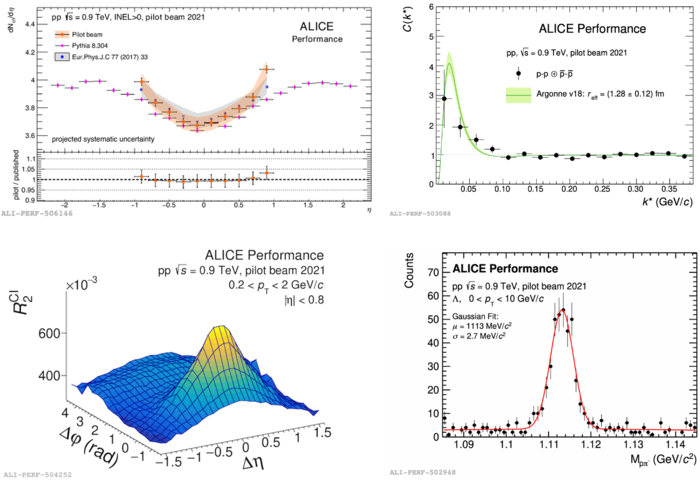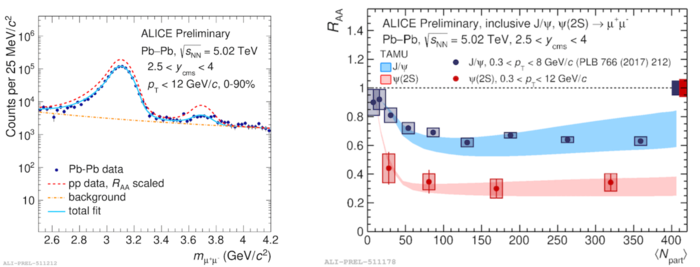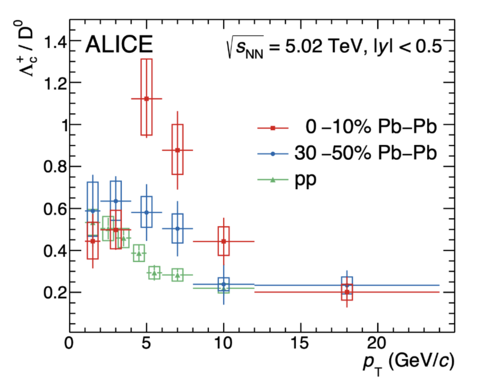
The ALICE Collaboration reports a wide range of new physics results at the Large Hadron Collider Physics conference (LHCP2022) this week (16-21 May 2022). The status of the upgraded detector commissioning for the LHC Run 3, prospects for further upgrades for Run 4, and the completely new heavy-ion detector ALICE 3 for Run 5 and beyond are also presented. The ALICE Collaboration participates in LHCP2022 with 6 plenary, 17 parallel and 11 poster presenters. The plenary presentation on 16 May reports the highlights of new ALICE measurements and the status of the experiment. A selection of these topics is presented in the following sections.
ALICE gears up for Run 3 at the LHC
The ALICE detector has undergone a major upgrade during the LHC long shutdown 2. New inner trackers, instrumented with monolithic active pixel detectors with a spatial resolution of about 5 microns, were installed in the central-rapidity barrel and forward muon-spectrometer acceptances. The new GEM-based readout planes of the time projection chamber, the new fast trigger detector, the readout upgrade of several other detector components, and an integrated online-offline processing system, will enable recording Pb-Pb collisions at an interaction rate of up to 50 kHz. The upgraded apparatus was commissioned with cosmic-ray muons and, in October 2021, with a proton-proton pilot run at the centre-of-mass energy of 900 GeV. A number of benchmark analyses of the new data were carried out in order to fully validate the new hardware, online and offline processing software, as well as a redesigned analysis framework that meets the larger data-throughput requirements of Run 3. The benchmark analyses included measurement of the charged-particle multiplicity distribution as a function of pseudorapidity, the momentum and angular correlations functions of charged particles and identified protons, as well as the reconstruction of strange hadron weak decays. ALICE is ready to start Run 3 with pp data-taking at the unprecedented centre-of-mass energy of 13.6 TeV from July and the lead-lead in November 2022!

ALICE event display of proton-proton collisions from the pilot LHC beam in October 2021 (left) and of muons from ‘beam splashes’ in the absorbers upstream of ALICE in April 2022 (right).

Analysis of the pilot beam data: charged-particle multiplicity compared to a measured with 2010 data; two-particle yield angular correlations; momentum correlation of identified proton pairs; invariant mass distribution of strange baryon decay candidates.
The antimatter-to-matter asymmetry in the little bang
The Universe contains only 5.4x10-10 baryons per photon. This ratio is so small, because almost all the matter particles annihilated with antimatter particles a few instants after the Big Bang. Pb-Pb collisions at the LHC create conditions similar to those of the early Universe. In such collisions, however, a much larger excess of matter with respect to antimatter is observed, because the initially-colliding nuclei are made of matter particles. ALICE measurements show about 1% more protons than antiprotons and about 6% more 3He nuclei (a bound state of two protons and a neutron) than anti-3He nuclei. Nevertheless, this shows that at the LHC we are much closer to recreating the conditions of the early Universe than at any other particle accelerator. In order to interpret all the measured antiparticle-to-particle ratios simultaneously, a thermodynamic description of the fireball produced in the collision is used. This thermal-statistical model is based on two free parameters: the temperature and the baryochemical potential that describes the additional energy needed to add a baryon with respect to an antibaryon to the system. While the temperature has been well constrained from the measurement of various particle species over the recent years, a new ALICE measurement improves the precision on the baryochemical potential by almost an order of magnitude.

Antiparticle-to-particle ratios in Pb-Pb collisions (three centrality classes shown). The fits with the black lines are used to estimate the baryochemical potential of the system.
Further information: http://alice-figure.web.cern.ch/node/21620
The shine from heavy-ion collisions
Photons are emitted during the entire duration of a heavy-ion collision. Prompt direct photons are produced in initial hard-parton scatterings, prior to the formation of the quark-gluon plasma (QGP), and dominate the photon spectrum at large values of the transverse momentum (pT). Because photons do not have a colour charge and thus do not interact with the QGP, their yield, well described by perturbative quantum chromodynamics (pQCD), directly reflects the rate of initial hard-scattering processes. Thermal direct photons are, instead, produced in the QGP and in the subsequent hot hadron gas. They are expected to give a significant contribution at low pT with a spectrum that falls off exponentially with pT. This is similar to the thermal radiation from a red-hot heating element, or the surface of the Sun. However, in heavy-ion collisions, the thermal photon spectrum is an effective average over the different volume elements in the QGP and the hadron gas at different temperatures. ALICE has previously reported the photon spectrum from Pb-Pb collisions collected in the LHC Run 1, which allowed us to infer an effective temperature of about 300 MeV. A new preliminary analysis of LHC Run 2 data at increased centre-of-mass energy of 5.02 TeV per nucleon-nucleon collision is presented for the first time at the conference. The photon spectrum is described well by calculations that include prompt pQCD photons from hard scatterings and thermal photons. These calculations suggest a dominance of thermal photons at pT<3 GeV/c. The analysis will be extended to the full data sample collected in Run 2 with the goal of estimating the effective temperature of the photons that shine from these collisions.

Further information: http://alice-figure.web.cern.ch/node/21776
Charmonia in the quark-gluon plasma: varying the binding energy
Charmonia, bound states of charm and anti-charm quarks, can be considered as unique probes of the deconfinement in the QGP. The charm-anticharm quark pairs are produced early in the heavy-ion collisions, but their binding into final-state particles is a longer process. In the presence of the strongly-interacting QGP medium, the binding is screened by the color charge of the deconfined quarks and gluons and the charmonia production is suppressed. The level of suppression depends on the charmonia binding energy and the QGP temperature. At LHC energies there is a counterbalancing process. The initially-produced charm and anticharm quarks interact with the QGP constituents, reaching close to thermalization, and further on can recombine into charmonium bound states. The recombination process is dependent on the size of the charmonia and the degree of thermalization of charm quarks. Therefore, the comparison of the production of different charmonium states can bring essential information on the properties of the QGP. The ψ(2S) charmonium state has ten-times smaller binding energy and twice larger size compared to the commonly-studied J/ψ state. Its experimental study is more difficult because of the much lower probabilities for both production and decay to a muon pair. ALICE reports the first measurement on the ψ(2S) charmonium state in Pb-Pb collisions down to zero transverse momentum. The results show a suppression about twice as large as for J/ψ. Theoretical predictions that include suppression and recombination of charmonia in the QGP describe the measurement.

The dimuon invariant mass distribution in Pb-Pb collisions, featuring ψ(2S) and J/ψ mass peaks, compared to the corresponding scaled distribution in pp collisions. The ψ(2S) and J/ψ suppression in Pb-Pb collisions compared to transport model calculations.
Further information: http://alice-figure.web.cern.ch/node/22451
Looking for the lost jets
Jets are sprays of collimated hadrons that result from the fragmentation of energetic quarks or gluons produced in hard scattering processes. In presence of a quark-gluon plasma (QGP) the interaction of the quarks and gluons as they traverse this medium causes jet quenching: the measured yields of energetic jets are reduced with respect to the expectation from proton-proton collisions. A possible explanation for jet quenching is additional medium-induced radiation of gluons at large angles with respect to the jet direction. As a consequence, the jet would be found by experimental algorithms with an energy much lower than its initial energy. ALICE uses a technique called hadron-jet recoil to search for these quenched jets. The yield of jets that are produced as a back-to-back pair (recoil) with an energetic hadron, called trigger hadron, is compared in nucleus-nucleus (AA) and proton-proton collisions by means of the IAA ratio. The yields of recoil jets are reduced by jet quenching when the energy of the jet is similar to that of the trigger hadron (IAA < 1). This effect is reproduced by jet quenching models (JETSCAPE in the figure). A new preliminary measurement extends for the first time the study to recoil jets with very small energy and shows a hint of increased jet yields (IAA > 1). The result opens the possibility to characterize jets that have undergone large energy loss in QGP.

Schematic representation of the measurement of a jet recoiling against a trigger hadron. Ratio IAA of the recoiling jet yields in nucleus-nucleus (‘AA’) and in pp collisions, compared to the JETSCAPE jet quenching simulation
Further information: http://alice-figure.web.cern.ch/node/18081
Constraining hadronisation mechanisms with charm baryons in Pb-Pb
A fundamental open question in particle physics concerns how hadrons are formed from quarks, especially in the quark-gluon plasma produced in nucleus-nucleus collisions. Open heavy-flavour production offers unique insights into the nature of the QGP medium and its hadronisation, in particular through the measurement of the baryon-to-meson production ratio. A significant enhancement of the Λc+/D0 ratio in heavy-ion collisions is predicted by theoretical models that include modified hadronisation mechanisms with respect to pp collisions, such as statistical hadronisation of thermalised charm quarks or coalescence of charm quarks with light quarks from the QGP. The production of prompt Λc+ baryons was measured with the ALICE detector in Pb-Pb collisions at 5.02 TeV, as well as the Λc+/D0 ratio and nuclear modification factor. The measured Λc+/D0 ratio increases from pp to central Pb-Pb collisions at intermediate transverse momentum pT. These results were compared with predictions from different theoretical models, and place significant constraints on charm-quark hadronisation. The upgraded ALICE detector for the LHC Runs 3 and 4 will increase the integrated luminosity by a factor of about 50 and the tracking precision by a factor 3-6, meaning future measurements of Λc+-baryon production will allow for even stronger constraints on the heavy-quark hadronisation mechanisms in heavy-ion collisions.

Further reading: arXiv:2112.08156
Small but flowing: hadron-dependent anisotropy in pp and p-Pb collisions
The plasma of quark and gluons (QGP) formed in ultra-relativistic collisions of heavy nuclei behaves as an almost perfect liquid. The hydrodynamic nature of the QGP medium results in the observed flow of the produced particles. There are two types of particle flow, the radial flow and the anisotropic flow. The radial flow is related to the common velocity field of the expanding QGP. The pressure gradients inside QGP transform the spatial anisotropies of the overlap area of the colliding nuclei into anisotropic flow. At low particle momenta, the anisotropic flow shows a characteristic particle-mass ordering. At higher momenta, the baryon particles composed of three quarks have about 50% higher flow with respect to the meson particles composed of quark-antiquark. This indicates that the flow arises already at the level of quarks, usually referred to as partonic flow, and that the hadron production at higher momenta is dominated by a quark coalescence.
Although initially unexpected, the particle flow has been also observed in small collision systems like proton-proton and proton-lead. Its origin is not yet fully clarified. Recent precise flow measurements of various hadron species by ALICE clearly indicate mass ordering at low momenta and baryon-meson splitting at higher momenta, thus bringing more similarities between the flow patterns measured in small and large collision systems.

Further information: http://alice-figure.web.cern.ch/node/21589
Accessing the residual strong force between charm and non-charm hadrons
Besides gravitation, electromagnetism, and the weak force, the strong force is one of the four fundamental forces of nature. It acts between quarks and binds them together in hadrons such as protons and neutrons. The residual force that attracts quarks of two separate hadrons is responsible for the binding of protons and neutrons to larger nuclei. While this residual strong force is well studied for hadrons that consist of up, down, and strange quarks, it has never been measured for those containing charm quarks. In ALICE, a special two-particle correlation technique called femtoscopy has been employed, which allows one to probe its strength. By looking at the distribution of the relative momentum difference of charged D meson (a charm quark bound to a down antiquark) and protons (two up quarks and one down quark), we can investigate if these particles rather attract each other or repel. While this force is strongly attractive between protons and neutrons, we have hints that D mesons are repelled from pions and attracted to protons.

Further reading: arXiv:2201.05352, http://alice-figure.web.cern.ch/node/22039
